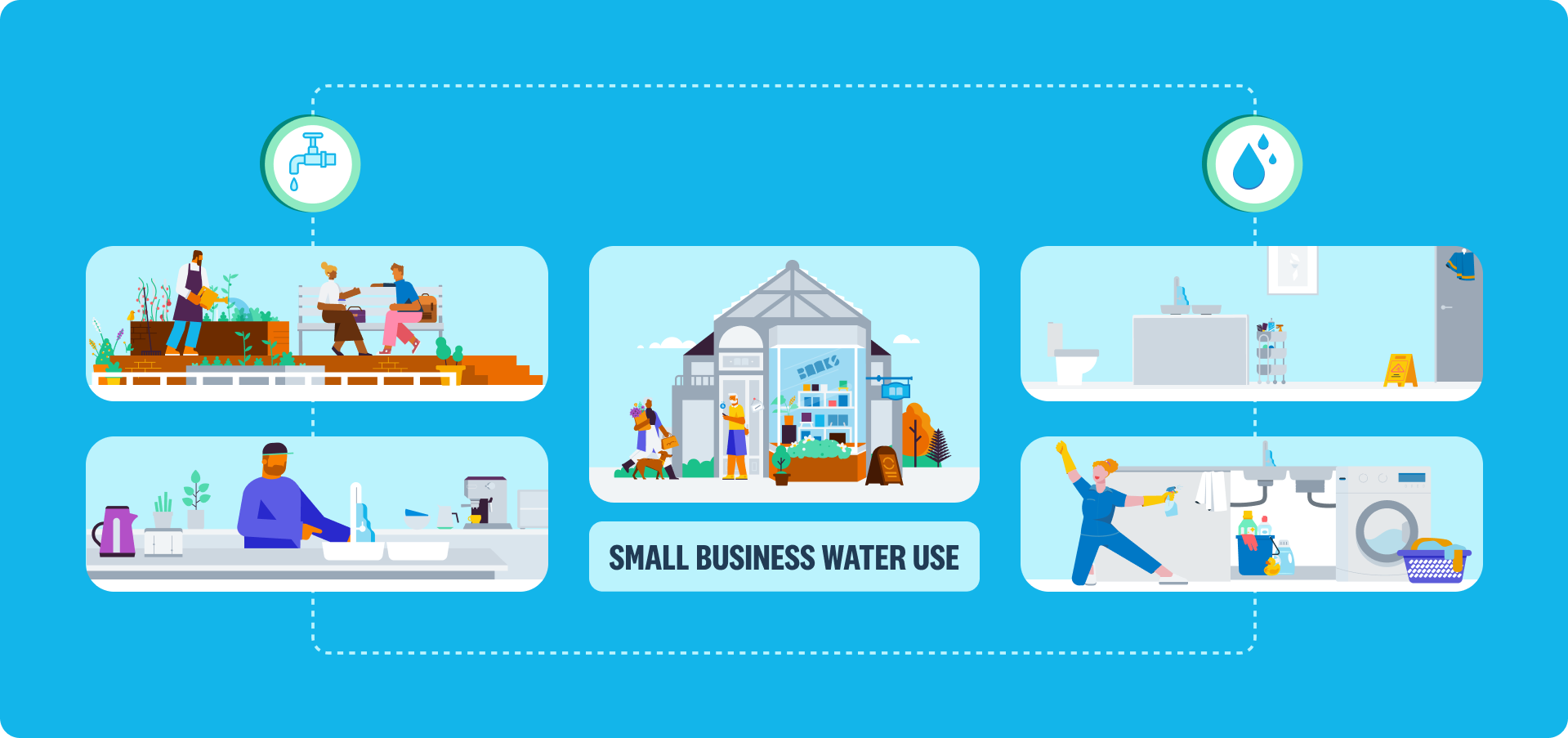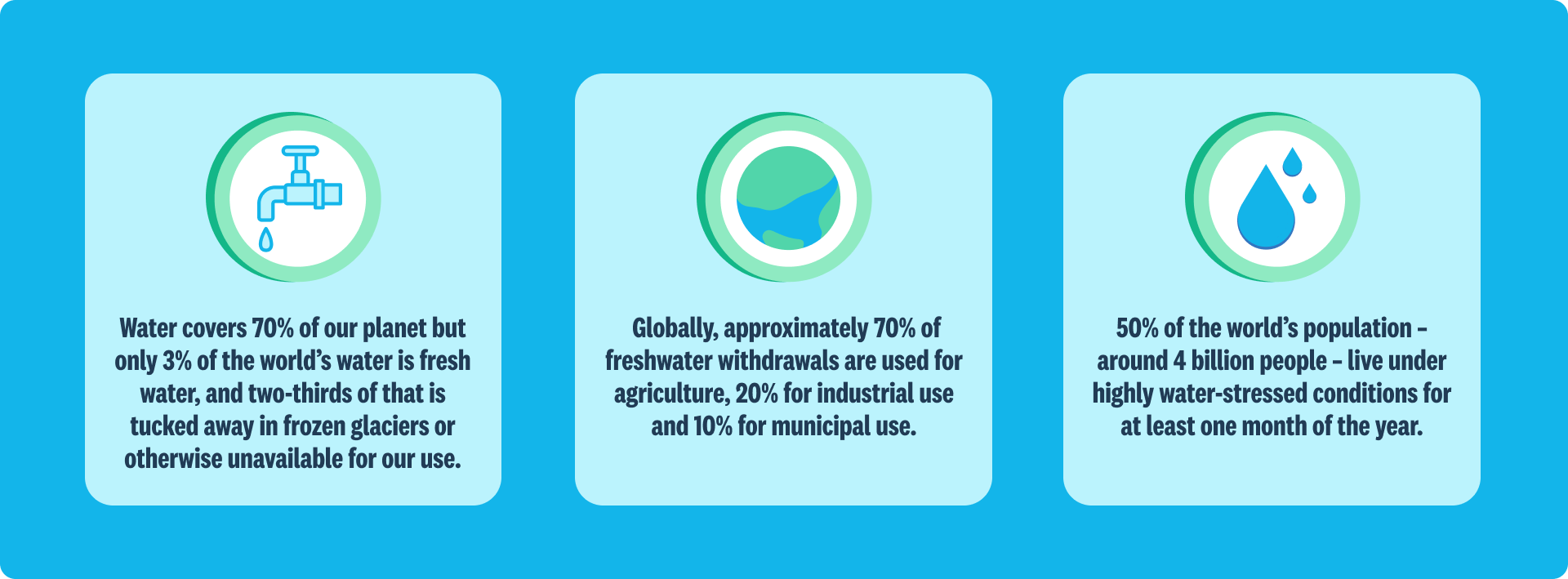Water use
How to use less water and make the most of alternative sources.

In this topic
What it is | Why it matters | Who it matters most for | What you can do
How to know if it's working | What the jargon means | How to learn more
What it is
Water often gets taken for granted until the bill spikes or restrictions hit. From bathrooms and kitchens to production and cooling systems, water quietly runs through almost every part of a business. Even if you don’t think of your business as a big water user, there are often simple ways to use less.
This guide focuses on how businesses can reduce their mains water use. It covers common ways water is used, practical changes you can make day to day, how to reuse water or switch to rainwater, and longer-term ideas for designing a more efficient setup. Note, for the topic of water discharge, see the how-to guide on chemicals and pollution.

Why it matters
Fresh water is one of the world’s most precious and limited resources. Climate change, population growth and pollution are placing huge pressure on rivers, lakes and underground aquifers.
Many communities now face serious water stress, meaning demand is higher than what nature can supply. In some regions, water scarcity is already affecting food production, ecosystems and public health.
Mains water may seem unlimited in countries like Australia, the UK, Canada or Singapore. But even in these places, droughts and restrictions are becoming more common. Water systems also rely on energy, so reducing water use lowers your carbon footprint too.
Small businesses play a role. Restaurants, laundries, farms, beauty services and even offices all use water every day. Multiplied across millions of businesses, small changes add up.
Taking action helps protect local water supplies, reduce environmental impact and lower your bills.

Sources: WWF; Our World in Data; WRI
Who it matters most for
Water use matters most for businesses that rely heavily on it for their operations, such as those in food production, textiles, cleaning, cooling, farming, manufacturing or personal care. These businesses face higher risks in drought-prone areas or where water prices or restrictions are rising.
But even if your business only uses water for bathrooms or a small kitchen, small changes can still save money and help protect this essential resource.
What you can do
Here are some practical and impactful ways you can address water use in your business.
Understand where and how you use water
Reuse water and tap into alternative sources
Invest in water-smart infrastructure
Understand where and how you use water
If you don’t know where water is being used, you won’t know where it might be wasted. A basic water audit is a great place to start. Walk through your site and note where water is used: bathrooms, kitchens, irrigation, laundry, production equipment, cleaning or cooling.
Compare this with your water bill. Most of the time, these will provide things like an average daily water use during that period, and a comparison to previous periods. Consider based on your observed water uses: does that daily water use amount make sense? And does the trend over time make sense, for example going up during hot, dry seasons, or are there unexplained increases?
Water bills are often provided quarterly, which doesn’t give you much detail to work with. If you’re a larger water user or something seems off, you might consider getting a sub-meter installed to give you more granular detail about when water is being used and how much goes to different areas, which can help spot irregularities.
It’s also important to consider water availability in your local area. Are you in a drought-prone region or one where people downstream are facing shortages? This might put more emphasis on reducing your own use.

Source: DEECA
Quick actions you can take
- Walk through your site and list all the areas where water is used
- Check your latest water bill and compare it to past months
- Check your water utility company’s website for support programs such as submeter installation and audits.
Use water wisely everyday
Conventional, high-flow taps, full-flush toilets and leaks are common culprits for water waste. But so are habits like leaving taps running or using more water than needed to clean.
Replacing old taps, shower heads and toilets with more efficient versions can make a big difference. Many water companies or government departments provide these for a discount or rebate. Consider water-efficient dishwashers and washing machines next time you need to upgrade those as well, and try to run them only only with full loads.
Posting small reminders for your team to reduce their use and turn off taps is also effective and free! In accommodation, hospitality or wellness services, you can also encourage guests to consider their use, including reusing towels to reduce laundry.
Keep an eye out for dripping taps and wet patches, including under sinks and water heaters, as well as on the ground outside. You can also ask your team to raise any concerns if they spot any leaks or unnecessary water use.

Source: US EPA WaterSense
Quick actions you can take
- Install tap aerators and low-flow shower heads in staff bathrooms
- Fix any dripping taps or leaking toilets
- Ask your team where they see water being wasted or used unnecessarily
Reuse water and tap into alternative sources
Using less water is one step. Using what would otherwise go to waste is even better.
Rainwater harvesting can be a simple way to reduce reliance on mains water, especially for outdoor areas, toilet flushing or washdown.
If your business produces greywater, such as from sinks or laundry, consider reusing it for landscaping, irrigation or non-contact cleaning, where regulations allow. If you do, make sure you choose cleaning and laundry products that are safe for greywater reuse.
For equipment that requires large volumes of water for cooling or rinsing, closed-loop or recirculating systems can make a big difference. This is common in manufacturing and other process-heavy businesses.

Sources: Imteaz, Shanableh, et al 2011; Radcliffe and Page 2020
Quick actions
- Install a rainwater tank for outdoor watering or toilet flushing
- Save final rinse water for the next round of cleaning (if hygiene allows)
- Ask your plumber if greywater reuse is possible for your site
Invest in water-smart infrastructure
Planning a fitout or new equipment? This is your chance to lock in long-term savings. Many modern appliances use far less water than older models. Look for water rating labels to choose appliances that will save you money over time.
Think about outside areas too. Native and drought-tolerant plants reduce the need for watering. Drip irrigation, mulching and watering in cooler hours all help cut water use. Also consider permeable surfaces, rain gardens and retention tanks to make the most of rainfall.
In high-use facilities such as spas, hydrotherapy centers, pools and irrigation, systems can be designed to filter, clean and recirculate water rather than discharge it, dramatically cutting use while maintaining quality and hygiene.
In many countries, water is likely to become less abundant, so it pays to start planning now.

Source: Water Sensitive Cities, 2025
Quick actions you can take
- Choose water-efficient models when replacing dishwashers or washing machines
- Choose drought-tolerant plants and use mulch to reduce water needed for landscaping
How to know if it's working
Compared to some other business impacts, water use is relatively easy to measure. Check your water utility bill! It’s useful to watch it for increases and decreases, as well as track what’s being used across your site.
Some common metrics include:
- Total water use (kL or L per year): The total volume of water consumed
- Water intensity (L per employee, customer, product or square metre): Helpful for comparing use over time, even if your business grows
- Percentage of water from alternative sources: The portion of water that comes from rainwater, greywater or other recycled sources
Common targets include reducing total water use by 10% to 30% over a few years, or increasing the share of water sourced from rainwater or reuse. For smaller businesses, you might alternatively consider setting action targets, like completing a water audit or getting a rainwater tank installed.
How to learn more
Guides to understanding water scarcity risk, conducting a water audit, conservation tips, water saving technologies and grants, and case studies.
Smart Water Solutions for SMEs (Allianz)Guides to understanding water scarcity risk, conducting a water audit, conservation tips, water saving technologies and grants, and case studies.
Smart Water Solutions for SMEs (Allianz)Covers the benefits of cutting down your water use, gives you tips for saving water and describes the financial support available for introducing water efficiency measures.
Water use and efficiency (NetRegs Scotland)Covers the benefits of cutting down your water use, gives you tips for saving water and describes the financial support available for introducing water efficiency measures.
Water use and efficiency (NetRegs Scotland)Best management practices for commercial and institutional facilities to understand and manage their water use and establish effective water management strategies.
WaterSense at Work (US EPA)Best management practices for commercial and institutional facilities to understand and manage their water use and establish effective water management strategies.
WaterSense at Work (US EPA)Guide to water conservation with an Asian lens.
SME Sustainability Hub (Singapore)Guide to water conservation with an Asian lens.
SME Sustainability Hub (Singapore)Tips on addressing leaks, irrigation, and employee behavior, offering Water Health Checks for Darwin businesses.
Saving water in the workplaceTips on addressing leaks, irrigation, and employee behavior, offering Water Health Checks for Darwin businesses.
Saving water in the workplaceA guide to help small and medium businesses carry out water footprint assessment according to the International Standard.
ISO 14046 Water footprint – A practical guide for SMEsA guide to help small and medium businesses carry out water footprint assessment according to the International Standard.
ISO 14046 Water footprint – A practical guide for SMEsIn-depth guide to strategies for applying lean manufacturing to reduce water use while improving operational performance and reducing costs.
Lean & Water Toolkit (US EPA)In-depth guide to strategies for applying lean manufacturing to reduce water use while improving operational performance and reducing costs.
Lean & Water Toolkit (US EPA)